|
|
| Home Topics Memorials Miscellany Transcripts References Family History Glossary Latest Beeston Blog About us | Site Search |
|
In the later part of the 19th century, the family had begun to diversify its operations in the area, first in association with Robert Foster, as Foster & Pearson, manufacturing horticultural buildings and later forming Beeston Foundary to make fittings and heating apparatus for these buildings. Ultimately, this evolved it into Beeston Boiler Company, a leading manufacturer of commercial and domestic heating apparatus. Towards the end of the 1880s, reflecting the business success, the family moved to The White House at the top of Town Street in Bramcote from where various branches of the family were to continue to oversee their business interests - and extensive philanthropic agenda - into well into the next century. Thus, at the time of the 1901 census the family is to be found living there with Henry John, then aged fifty, shown as Chairman of Beeston Foundry Company, with his wife Laura Kate, four years younger than her husband. Their eldest daughter, Eva Winifred (b. 1878) and another daughter, Elizabeth Marjory (b. 1885) were absent but their daughter Laura Dorothy (b. 1880), Stephen Hetley, his twin John Strachan, a younger son Noel Gervase (b. 1884) and their youngest daughter, Mary Janet (b. 1891) were all at home. Also living with the family was Mrs Pearson's widowed mother, 86 year old Catherine Jean Rogers. The household was supported by a governess and four domestic servants.1 Stephen Hetley Pearson was educated at Charterhouse School2 and then trained as a Chartered Accountant and went on to use these skills in the family business. His twin brother, John Strachan Pearson, became a farmer and eventually left for New Zealand. Stephen Hetley continued to develop his interest in the training of local boys, reforming the Boys Brigade and, together with others in the family and following his father's death in 1913, he give generously to establish the Lads Club.3 His pioneering and inspiring work with the youth of Beeston and his influance when war came was well described in the local press when he himself made the Supreme Sacrifice in 1917. The Nottingham Guardian, 10th December 1917: Saturday 1st December was the blackest day in the history of the Beeston Lads Club. It was during the morning of this fateful day that the Founder and Captain of the 17th Nottingham (Beeston) Company Boys Brigade, Stephen Hetley Pearson was killed in action during the Guards Brigade's counter attack against the enemy in the later stages of the Cambrai Offensive. The Beeston Gazette & Echo readily endorsed these feelings: Beeston Boys Brigade Loses Its Best Friend - an Appreciation - Beeston has been plunged into mourning by the news received yesterday by the Rev. H.W. Gooch (acting Captain of the Beeston Company of the Boys Brigade) from the chaplain of the Grenadier Guards at the front that Lieutenant S. Hetley Pearson has been killed while leading his men in action. It is not much to say that "Mr Hetley", as he was affectionately known at Beeston, has left behind an imperishable name, engraved not on bricks and stones, but in the hearts of the lads he laboured amongst with such enthusiastic zeal, and his example of splendid manhood will live as as long as the Boys Brigade, with which he was so prominently identified endures. He was the "big brother" of every boy in his company and in season and out of season he set his lofty ambition before him - to lead the lads entrusted to his care to fear God and to follow the path of duty regardless of the consequences. He was a pioneer and an adventurer in the best sense of the word. Long before the Governments thought it worthwhile to set up "advisory boards" to deal with the problem of the boy - we realize there is a "boy" problem nowadays - Mr Hetley dedicated his life to this work. His Last Letter Home - 2nd Lieutenant Stephen Hetley Pearsonís last letter was sent to Mr Clayton, from France, was dated 25th November 1917, just six days before he was reported missing, believed Killed In Action. As this letter, as so many others in the 1914-18 War, was written in pencil, it is difficult to read but the following is believed to be an accurate copy Dear Mr. Clayton, Just a short line to tell you it as taken me 3 days to reach our Reinforcement Battalion and I have yet to join my Battalion proper. All of it is new country to me, pleasant in places with good main roads, but every now and again we come over signs of Hun destruction & devastation. Some places have been very wantonly destroyed and it makes me very disgusted. This letter shows what a caring and remarkable man Stephen Hetley Pearson was; his concern for the boys and staff of the Lads Club more important to him than anything else.
In 1917 the Western Front was locked in grim conflict and during the summer and autumn the fruitless 3rd Battle of Ypres was consuming the energies and resources of the British Army. By October it was clear to Field Marshall Haig that any further assaults over the Flanders quagmire might well prove worthless. He therefore devised a plan in which a large tank force was to make a full scale offensive in the area of Cambria. This offensive staged on 20th November, was at first thought to be a complete success, unfortunately owing to lack of exploitation and reserves, the impetus of the attack was spent by 29th November leaving only a vulnerable salient some nine miles wide and four miles deep. The Germans were quick to see this weakness, so on the 30th November they attacked and overwhelmed the villages of Gonnelieu and Gouzeacourt. The Guards Division had spent much of the time in reserve but now they were required to restore the situation. On the same day, the 1st Guards Brigade consisting the 2nd Battalion Grenadiers and two battalions of Coldstream Guards recaptured Gouzeaucourt. The 3rd Guards Brigade passed through Gouzeaucourt and took up a position just east of the town poised to attack Gonnelieu. The 1st Guards Brigade was now ordered to recapture the Quentin Ridge which included Gauge Wood. The 2nd Battalion Grenadier Guards was to be the right assault battalion of the Brigade, and on their right was to be the 18th Bengal Lancers, the left assault regiment being the now dismounted Ambala Cavalry Brigade. Gauche Wood was The object for both units, 2nd Grenadiers left and the 18th Bengal Lancers right; thus the wood was divided by a divisional boundary, a fact that was to cause subsequent chaos.  Looking towards Gauche Wood and Villers Guislain Gauche Wood was oblong in shape and measured some 700 by 300 yards, being about 13 acres and surprisingly untouched by shellfire with tall trees and undergrowth. Its importance lay in the fact that it dominated the approaches to Gonnelieu and Villers Guislain both of which were subsequent objectives of 3rd Corps. The strength of the enemy in Gauge Wood was not known in detail but was thought to be about a company. Sometime during the late hours of 30th November orders were issued for an attack at 06.30 the next morning. The assault was to be mounted from the area of the sunken road south-east of Gouzeaucourt which now formed a front line and which was some 1200 yards from the objective. Tanks were to precede the companies by 400 yards. No 1 Company (Lt. Cornforth) was right forward, 2nd Lieutenant Pearson was in No 1 Company having rejoined his battalion only days previously. Also with No 1 Company was 2nd Lieutenant Harbord. No 3 Company (Lt. Acland) was left forward with No 2 (Lt. Boy Browning) and No 4 (Lt. Guy Westmacott) companies in reserve 250 yards in the rear. At 06.30 the artillery fire plan commenced but the company commanders could see no sign of the promised tanks. By 06.45 the Battalion Commander Colonel Rasche's patience was exhausted and, as the battalion was also being shelled in their position, he ordered them to advance without the tank support. Meanwhile the 18th Lancers were faring a little better; after a bad night without a hot meal they faced a dismounted advance across undulating country for about half a mile, not a very cheerful prospect for a regiment practised in mounted drills. Like the Grenadiers they waited for the tanks to appear, but unlike the guardsmen, they decided to wait for the tanks, since they had suffered casualties during their move to the start line. The Grenadiers unsupported advance continued up the hill towards the outline of the wood. Ignoring all regulations about short rushes, both officers and men went straight for the wood as fast as they could. It was not until they had nearly reached the wood that the enemy's concealed machine guns caused all the casualties. It was during this attack that 2nd Lieutenants Philip Anthony Asherton Harbord (buried Plot II. Row D. Grave 2. Fins New British Cemetery Sorel-Le-Grand), and 2nd Lieutenant Stephen Hetley Pearson, were killed leading their men into the wood. Once the leading companies (1 & 3) had closed with the enemy on the northern edge of the wood, fierce hand to hand fighting took place and soon most of the enemy were either killed or captured. Lieutenant Guy Westmacott commanding No 4 Company wisely moved his platoons to the south western edge in order to protect the right flank of the battalion. It was as well that he did for immediately they were rushed by about seventy of the enemy from the south, but the guardsmen stood firm and the attack was repulsed. Lt. Westmacott now found himself to be the only officer in the western part of the wood, as several officers had been killed or wounded during the assault. He therefore set about reorganising the battalion into a defensive position along the southern edge of the wood. At about 0715-0730 the Lancers advanced up the hill complete with the long awaited tanks under considerable fire. Supported by the Grenadiers, the Bengalis entered the wood and pressed to the north eastern edge, where they discovered a battery of enemy howitzers intact and abandoned. Now followed a period of chaos during which the tanks milled round attracting unpopular shelling and the Grenadiers got mixed up with the Bengalis. With the lack of Grenadier officers, guardsmen soon found themselves commanded by Lancer Officers. Enemy shelling encouraged Grenadier & Bengali alike to dig in vigorously. At 10.00 Colonel Rasch arrived to inspect the line and arranged with Lt. Col. Corbyn of the 18th Lancers that the Lancer Officers should continue to command the guardsmen. The engagement was now virtually over although the shelling continued and sadly accounted for the death of Lt. Col. E. C. Corbyn, the Commanding Officer of the Bengal Lancers, who is buried in Plot C. Grave 7, Heudicourt Communal Cemetery Extension. At 2100 the Regiment & Battalion were relieved by the Deccan and Poona Horse and so ended a memorable day. For his gallantry in this action Lt. Westmacott was awarded the Distinguished Service Order. The Battle of Cambrai was, in material terms, a disappointment as, on 4th December, the line was virtually what it had been on 20th November when the battle started. Nevertheless this engagement forged an historic link between both regiments, which was strengthened after the war by the exchange of gifts; the 2nd Battalion Grenadier Guards was presented with the splendid Silver Lancer and in return they gave the Bengal Lancers a Silver Bugle which remains a proud relic today in the Officers Mess of the Pakistani Regiment, the 19th Lancers, the inheritors of the old Indian Army Regiment. The link lives on to this day by the exchange of telegrams on 1st December, Gauche Wood Day, each year. As well as the two Officers killed during this engagement the 2nd Battalion lost 38 men killed in action with many more casualties, including Sergeant Harry Ward who had previously worked at the Ericssons Factory in Beeston.
Both of 2nd Lieutenant Stephen Hetley Pearson's two brothers served during the Great War. His twin brother John Strachan Pearson had emigrated to New Zealand before the War began. He achieved the rank of Corporal while serving with the New Zealand Machine Gun Corps. He died in Egypt just seven days before the Armistice was signed, and was buried in Plot A. Grave 177 of the Alexandria (Hadra) War Memorial Cemetery. Noel Gervise Pearson, the twin"s younger brother served with great distiction during the War.At the outbreak of the War in 1914, he enlisted in the 9th Sherwood Foresters Regiment. He was made Adjutant in January 1915 and served overseas with various units until March 1919. He was awarded the Military Cross in 1916, the Distinguished Service Order in 1918, and was twice mentioned in dispatches. After the war Noel Gervise Pearson became the Managing Director of Beeston Boiler Company. He became President of the Beeston Branch British Legion, a Trustee of the 17th Battalion Boys Brigade and Notts County Commissioner Boy Scouts in 1940. He was President of the Nottingham Children"s Hospital 1928-1929, he was also the Chairman & President of Nottingham General Hospital between 1930 & 1948. Two of his sons made the Supreme Sacrifice in the 1939-1945 War Pilot Officer Henry Hetley Pearson was killed on Sunday, 17th August 1941, aged 21A third son, Mark, the twin brother of Basil John, served in the same regiment as his twin brother. He took over from his father at Beeston Boiler Company, but did not live to see the firm go into liquidation.
I know that my Redeemer Liveth Pearson was actually killed at 08.00 hours on 1st December 1917 at Gauche Wood about four miles away. Keith placed a small Cross of Remembrance bearing a poppy and a B.B. badge on the grave of Stephen Hetley Pearson. The grave is flanked on both sides by the graves of unknown soldiers simply marked "A Soldier of the Great War".
Villers-Faucon was captured by the 5th Cavalry Division on 27 March 1917, lost on 22 March 1918, and retaken by the III Corps on 7 September 1918. The Commonwealth graves in the Communal Cemetery are those of soldiers who died in February-August 1917, or (in the case of two who are buried in Row B) in September 1918. They were made by the cavalry, the 42nd (East Lancashire) Division, and other fighting troops. The Communal Cemetery contains 227 First World War burials, five of them unidentified, and 91 German graves. The adjoining Extension was begun in April 1917 and used until March 1918. It was then used by the Germans, and Commonwealth burials were resumed in September and October 1918. Further Commonwealth graves were brought in after the Armistice from a wide area round Villers-Faucon. The extension contains 459 Commonwealth burials and commemorations of the First World War. 144 of the burials are unidentified but there are special memorials to six casualties believed to be buried among them. The extension also contains 66 German graves, 33 being unidentified. The Commonwealth plots were designed by Sir Herbert Baker5. Footnotes 1Bramcote, Notts - Census 1901 - Piece 3208 Folio 45. The White House was occupied by various members of the Pearson Family, latterly by Noel Gervis Pearson, up to 1958. The building, prominently situated at the top of Town Street and extending round the bend in the road, is now a retirement home. 2Stephen Hetley Pearson is remembered in the Memorial Chapel at Charterhouse School, built to commemorate the nearly 700 from the school who died in the Great War. 3Donations from the family largely funded both the Lads Club building on Station Road and the sports field on Queens Road. Henry John Pearson gave generously towards the fund for the establishment of recreation grounds in Beeston. The family of Gervas Pearson were generous benefactors to local hospitals, churches and youth movements. 4The address to which Laura Kate Pearson moved as a widow. She later moved to Goldalming, Surrey and then to Ightham, Kent. She died in 1938. 5The description of Villers-Faucon Cemetery is based on that on the Commonwealth War Graves Commission website. (http://www.cwgc.org) |
|
|||||||||||||||||||||||||||||||||||||||||||||||||||||||||||||||||||||||||||||||||||||||||||||||||||||||||||||||||||||||||||||||||||||||||||||||||||||||||||||||||||||||||||||||||||||||||||||||||||||||||||||||||||||||||
|
|
|||||||||||||||||||||||||||||||||||||||||||||||||||||||||||||||||||||||||||||||||||||||||||||||||||||||||||||||||||||||||||||||||||||||||||||||||||||||||||||||||||||||||||||||||||||||||||||||||||||||||||||||||||||||||||
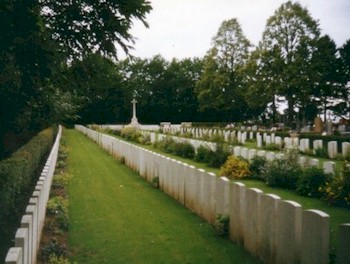
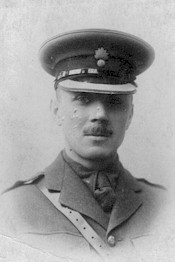 Stephen Hetley Pearson was born in Beeston on 30 Jun 1882. He and his twin brother, John Strachen Pearson, were the oldest sons and third and fourth children
of Henry John and Laura Kate (née Rogers) Pearson. Their baptism at Attenborough Parish Church on 13 August 1882 reflected the long association of the Pearson
family with Chilwell - then part of Attenborough Parish - and where it is said to have first settled in the mid-18th century and had become established, first as farmers
and, more famously, as nurserymen. The choice of Hetley as a middle name was from their paternal grandmother's family name; similarly, the choice of Strachen
was from their maternal grandmoth's family name.
Stephen Hetley Pearson was born in Beeston on 30 Jun 1882. He and his twin brother, John Strachen Pearson, were the oldest sons and third and fourth children
of Henry John and Laura Kate (née Rogers) Pearson. Their baptism at Attenborough Parish Church on 13 August 1882 reflected the long association of the Pearson
family with Chilwell - then part of Attenborough Parish - and where it is said to have first settled in the mid-18th century and had become established, first as farmers
and, more famously, as nurserymen. The choice of Hetley as a middle name was from their paternal grandmother's family name; similarly, the choice of Strachen
was from their maternal grandmoth's family name.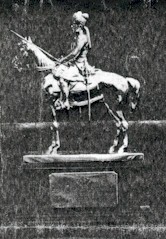 An insight into the Battle which saw the death of Stephen Hetley Pearson - Visitors to the Officers Mess of the 2nd Battalion Grenadier Guards are often surprised to find
the (Shown right) silver figure of a Bengal Lancer displayed on the dining room table. Few of the Grenadiers know of the connection with the 18th Bengal Lancers and even fewer of
the circumstances of Gauge Wood, round which engagement this linked was forged.
An insight into the Battle which saw the death of Stephen Hetley Pearson - Visitors to the Officers Mess of the 2nd Battalion Grenadier Guards are often surprised to find
the (Shown right) silver figure of a Bengal Lancer displayed on the dining room table. Few of the Grenadiers know of the connection with the 18th Bengal Lancers and even fewer of
the circumstances of Gauge Wood, round which engagement this linked was forged.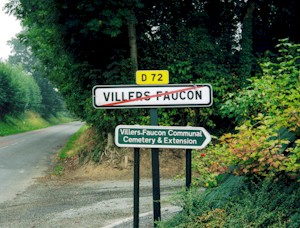 A Visit to Villers-Faucon - On the 14th September 1999, Keith Vizard visited the village of Villers-Faucon, which is about 17 kilometres north-east of Peronne in the Picardie Region of France. These
photographs and short history were sent to Ray Smedley, who treasure them.
A Visit to Villers-Faucon - On the 14th September 1999, Keith Vizard visited the village of Villers-Faucon, which is about 17 kilometres north-east of Peronne in the Picardie Region of France. These
photographs and short history were sent to Ray Smedley, who treasure them. The first section of the Cemetery is either side of a wide central path leading to a life-size crucifix and here are many local graves and family vaults. At the top end of the cemetery can clearly be
seen the white crosses marking the graves of soldiers killed in the First World War. The cemetery contains 227 British and 90 German graves, nearly all from 1917, in the civilian section and 453 British and 66
German graves in the Extension.
The first section of the Cemetery is either side of a wide central path leading to a life-size crucifix and here are many local graves and family vaults. At the top end of the cemetery can clearly be
seen the white crosses marking the graves of soldiers killed in the First World War. The cemetery contains 227 British and 90 German graves, nearly all from 1917, in the civilian section and 453 British and 66
German graves in the Extension.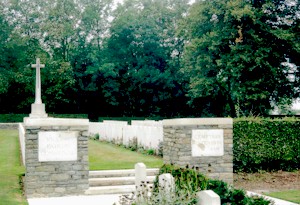 Two stone buttresses mark the entrance to "Villers Faucon Communal Cemetery Extension" which is edged by a low hedge. On the right is a large lime tree under which is Plot IV, Row A, Grave 6 marking
the burial place with the inscription:
Two stone buttresses mark the entrance to "Villers Faucon Communal Cemetery Extension" which is edged by a low hedge. On the right is a large lime tree under which is Plot IV, Row A, Grave 6 marking
the burial place with the inscription: